Washingtonia filifera
Washingtonia filifera, also known as desert fan palm,[4] California fan palm, or California palm,[5][6][7] is a flowering plant in the palm family (Arecaceae) native to the far southwestern United States and Baja California. Growing to 15–20 m (49–66 ft) tall by 3–6 m (10–20 ft) broad, it is an evergreen monocot with a tree-like growth habit. It has a sturdy, columnar trunk and waxy, fan-shaped (palmate) leaves.

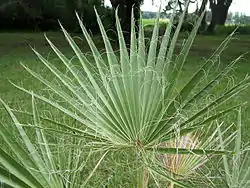
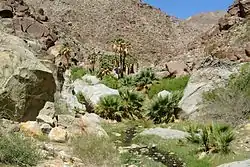
| Washingtonia filifera | |
|---|---|
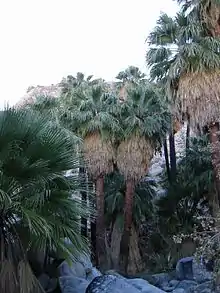 | |
| Washingtonia filifera in native grove near Twentynine Palms, California | |
| Scientific classification | |
| Kingdom: | Plantae |
| Clade: | Tracheophytes |
| Clade: | Angiosperms |
| Clade: | Monocots |
| Clade: | Commelinids |
| Order: | Arecales |
| Family: | Arecaceae |
| Genus: | Washingtonia |
| Species: | W. filifera |
| Binomial name | |
| Washingtonia filifera | |
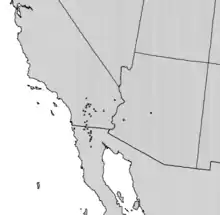 | |
| Natural range | |
| Synonyms[2][3] | |
| |
Names
Other common names include California fan palm and petticoat palm. The specific epithet filifera means "thread-bearing".
Distribution
W. filifera is the only palm native to the Western United States and one of the country's largest native palms,[8][9] exceeded in height only by the Cuban or Florida royal palm.[10]
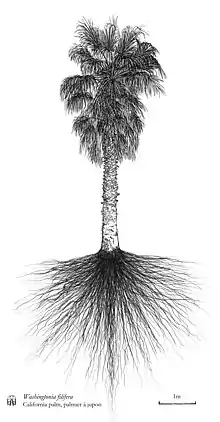
Primary populations are found in desert riparian habitats at spring-fed and stream-fed oases in the Colorado Desert[11] and at a few scattered locations in the Mojave Desert.[12] It is also found near watercourses in the Sonoran Desert along the Gila River in Yuma,[13] along the Hassayampa River and near New River in Maricopa County, and in portions of Pima County, Pinal County, Mohave County (along the Colorado River), and several other isolated locations in Clark County, Nevada. It is a naturalized species in the warm springs near Death Valley and in the extreme northwest of Sonora (Mexico). It is also reportedly naturalized in the South and Southeast Texas, Florida, Hawaii, the U.S. Virgin Islands, and Australia.[14][15]
Description
W. filifera grows to 18 m (59 ft) in height (occasionally to 25 m (82 ft)) in ideal conditions. The California fan palm is also known as the desert fan palm, American cotton palm, and Arizona fan palm.
The fronds are up to 4 m (13 ft) long, made up of a petiole up to 2 m (6.6 ft) long, bearing a fan of leaflets 1.5–2.0 m (4.9–6.6 ft) long. They have long, thread-like, white fibers, and the petioles are pure green with yellow edges and filifera-filaments, between the segments. The trunk is gray and tan, and the leaves are gray green. When the fronds die, they remain attached and drop down to cloak the trunk in a wide skirt. The shelter that the skirt creates provides a microhabitat for many small birds and invertebrates.
W. filifera typically lives from 80 to 250 years or more.
Ecology
Desert fan palms provide habitat for the giant palm-boring beetle, western yellow bat, hooded oriole, and many other bird species. Hooded orioles rely on the trees for food and places to build nests. Numerous insect species visit the hanging inflorescences that appear in late spring.[16]
Historically, natural oases are mainly restricted to areas downstream from the source of hot springs, though water is not always visible at the surface.
Today's oasis environment may have been protected from colder climatic changes over the course of its evolution. Thus, this palm is restricted by both water and climate to widely separated relict groves.[17] The trees in these groves show little if any genetic differentiation, (through electrophoretic examination), suggesting that the genus is genetically very stable.
Fire Adaptations
Fan palm oases have historically been subject to both natural and manmade fires. Fires are rarely fatal for the fan palm, but it is also not completely immune to them.
The fan palm's trunk is heavily resistant to burning. In most cases, the trunk is only at risk of losing some of its outer vascular layers during a fire. After those layers are ignited and burnt off, the remaining surface is left heavily charred, which fortifies the trunk against future flames. Subsequent burnings serve to char the trunk more, further increasing its fire resistance.
The palm's fronds are the most flammable portion of the tree. The unchecked buildup of dead fronds as a 'skirt' around the trunk can be especially dangerous in a crown fire. A severe accumulation of them could constitute enough kindling to completely burn through the trunk, killing the tree. However, if a palm can survive the burning of its fronds, they will take time to regrow, leaving it less susceptible to fire in the meantime.
Barring extreme, fatal conditions, fires are even conducive to the health and propagation of fan palms. The palms' reproduction process benefits from burnings, as fires help release saplings and clear away overgrowth from surrounding vegetation. Fires can also help palms conserve water by burning away their crowns and parts of their trunks, leading to a reduction in surface area and therefore decreased rates of evaporation and transpiration.[18]
Threats
Grazing animals can kill young plants through trampling, or by eating the terminus at the apical meristem, the growing portion of the plant. This may have kept palms restricted to a lesser range than indicated by the availability of water.
The palm boring beetle Dinapate wrightii (Bostrichidae) can chew through the trunks of this and other palms. Eventually, a continued infestation of beetles can kill various genera and species of palms. W. filifera appears to be resistant to the red palm weevil (Rhynchophorus ferrugineus) by a mechanism of antibiosis — production of compounds lethal to the larvae.[19][20][21]
Currently, the desert fan palm is experiencing a population and range expansion, perhaps due to global warming[22][23] or removing excess mustangs.
Uses
The sweet fruit pulp of the fan palm is edible.[24] The fruit was eaten raw, cooked, or ground into flour for cakes by Native Americans.[25] The Cahuilla and related tribes used the leaves to make sandals, thatch roofs, and baskets. The stems were used to make cooking utensils. The Moapa band of Paiutes and other Southern Paiutes have written memories of using this palm's seed, fruit, or leaves for various purposes including starvation food.[26][27] The bud (known as a heart of palm) has also been eaten.[28]
Access
Joshua Tree National Park in the Mojave Desert preserves and protects healthy riparian palm habitat examples in the Little San Bernardino Mountains, and westward where water rises through the San Andreas Fault on the east valley side. In the central Coachella Valley, the Indio Hills Palms State Reserve and nearby Coachella Valley Preserve, other large oases are protected and accessible. The Santa Rosa and San Jacinto Mountains National Monument, and Anza-Borrego Desert State Park both have large and diverse W. filifera canyon oasis habitats.
Cultivation
W. filifera is widely cultivated as an ornamental tree. It is one of the hardiest Coryphoideae palms, rated as hardy to USDA hardiness zone 8. It can survive brief temperatures of −10 °C (14 °F) with minor damage, and established plants have survived, with severe leaf damage, brief periods as low as −12 °C (10 °F). The plants grow best in Mediterranean climates, but can be found in humid subtropical climates such as eastern Australia and the southeastern USA. It has gained the Royal Horticultural Society's Award of Garden Merit.[29][30]
See also
- Washingtonia robusta Mexican fan palm
- Washingtonia x filibusta hybrid
References
- Johnson (1998). "Washingtonia filifera". IUCN Red List of Threatened Species. 1998. Retrieved 11 May 2006.CS1 maint: ref=harv (link)
- "Washingtonia filifera (Linden ex André) H. Wendl. ex de Bary". Tropicos.org. Missouri Botanical Garden. Retrieved 20 June 2014.
- "Washingtonia filifera (Linden ex André) H.Wendl. ex de Bary". PlantList. 2013. Retrieved 20 June 2014.
- Cornett, J. W. (1986). "The Common Name of Washingtonia filifera". Principes. 30 (4): 153–155.
- Griffin, Bruce (2000). A Natural History of the Sonoran Desert. University of California Press. Page 165. ISBN 9780520219809.
- Kearney, Thomas and Robert Hibbs Peebles (1960). Arizona Flora. University of California Press. Page 164. ISBN 9780520006379.
- Flora of North America Association. Flora of North America: North of Mexico Volume 22: Magnoliophyta: Alismatidae, Arecidae, Commelinidae(in Part), and Zingiberidae. Pages 105-106. ISBN 9780195137293.
- Hogan, C. Michael (5 January 2009). "California Fan Palm (Washingtonia filifera)". iGoTerra. Retrieved 20 June 2014.
- Clover, E.U. (April 1937). "Vegetational survey of the lower Rio Grand Valley, Texas". Madroño. 4 (2): 41–66. JSTOR 41422215.
- Flora of North America Association. Flora of North America: North of Mexico Volume 22: Magnoliophyta: Alismatidae, Arecidae, Commelinidae(in Part), and Zingiberidae. Pages 116-117. ISBN 0195137299.
- Cornett, James W. (1997). The Sonoran Desert: A Brief Natural History. Palm Springs, California: Palm Springs Desert Museum. ISBN 0-937794-27-9.
- Cornett, James W. (1987). Naturalized Populations of the Desert Fan Palm, Washingtonia filifera, in Death Valley National Monument in Plant Biology of Eastern California. Los Angeles, California: White Mountain Research Station, University of California, Los Angeles. pp. 167–174.
- Mark Nothaft (22 March 2016). "Are palm trees native to Arizona?". Retrieved 26 March 2016.
Mark Fleming, curator of botany at the Arizona-Sonora Desert Museum of Tucson, says Washingtonia filifera, or the California fan palm, is the state's only naturally occurring variety and that they are found in pockets around southern California, Northern Mexico, and one or two pockets in Arizona.
- "Plant Profile for Washingtonia filifera (California fan palm)". Natural Resources Conservation Service. United States Department of Agriculture. Retrieved 20 June 2014.
- Govaerts, R. "Washingtonia filifera (Rafarin) H.Wendl. ex de Bary, Bot. Zeitung (Berlin) 37: LXI (1879)". World Checklist of Selected Plant Families. Retrieved 21 June 2014.
- Cornett, J. W. 1986. Arthropod visitors at Washingtonia filifera (Wendl) Flowers. Pan Pacific Entomologist 62(3):224-225.
- "Desert Fan Palms-Evidence suggests "Relict Genus"". www.xeri.com. Retrieved 10 December 2016.
- Vogl, Richard; McHargue, Lawrence (1966). "Vegetation of California Fan Palm Oases on the San Andreas Fault". Ecological Society of America. 47 (4): 532–540. doi:10.2307/1933929. JSTOR 1933929.CS1 maint: multiple names: authors list (link)
- Nisson, N.; Hodel, D.; Hoddle, M. "Red Palm Weevil". Center for Invasive Species Research. University of California Riverside. Retrieved 20 June 2014.
- Dembilio, Ó.; Jacas, J.A.; Llácer, E. (August 2009). "Are the palms Washingtonia filifera and Chamaerops humilis suitable hosts for the red palm weevil, Rhynchophorus ferrugineus (Col. Curculionidae)?". Journal of Applied Entomology. 133 (7): 565–567. doi:10.1111/j.1439-0418.2009.01385.x. S2CID 85677945.
- Monroy, F.; Curir, P.; Clematis, F.; Cangelosi, B. (June 2016). "Susceptibility and possible resistance mechanisms in the palm species Phoenix dactylifera, Chamaerops humilis and Washingtonia filifera against Rhynchophorus ferrugineus (Olivier, 1790) (Coleoptera: Curculionidae)". Bulletin of Entomological Research. 106 (3): 341–346. doi:10.1017/S000748531500108X. ISSN 0007-4853. PMID 26976073.
- Cornett, James W. (2010). Desert Palm Oasis (Second ed.). Palm Springs, California: Nature Trails Press. ISBN 978-0-937794-42-5.
- "global warming & W.filifera Palms-a rebuttal". www.xeri.com. Retrieved 10 December 2016.
- Little, Elbert L. (1994) [1980]. The Audubon Society Field Guide to North American Trees: Western Region (Chanticleer Press ed.). Knopf. p. 325. ISBN 0394507614.
- Cornett, James W. (2011). Indian Uses of Desert Plants (Third ed.). Palm Springs, California: Nature Trails Press. ISBN 978-0-937794-45-6.
- Spencer, W. (1995). "Washingtonia filifera: Nevada's rejected ancient Palm". xeri.com. Retrieved 21 June 2014.
- Spencer, W. (1995). "A report regarding: The Palm - Washingtonia filifera - in Moapa NV". xeri.com. Retrieved 21 June 2014.
- Peattie, Donald Culross (1953). A Natural History of Western Trees. New York: Bonanza Books. p. 299.
- "Washingtonia filifera: Washington palm". RHS Gardening. Royal Horticultural Society. Retrieved 21 June 2014.
- "California Fan Palm, Washingtonia filifera". realpalmtrees.com.
Further reading
- Floridata.com: Washingtonia filifera
- Cornett, J. W. 2010. Desert Palm Oasis. Nature Trails Press, Palm Springs, California.
- Interactive Distribution Map for Washingtonia filifera
External links
| Wikimedia Commons has media related to Washingtonia filifera. |
